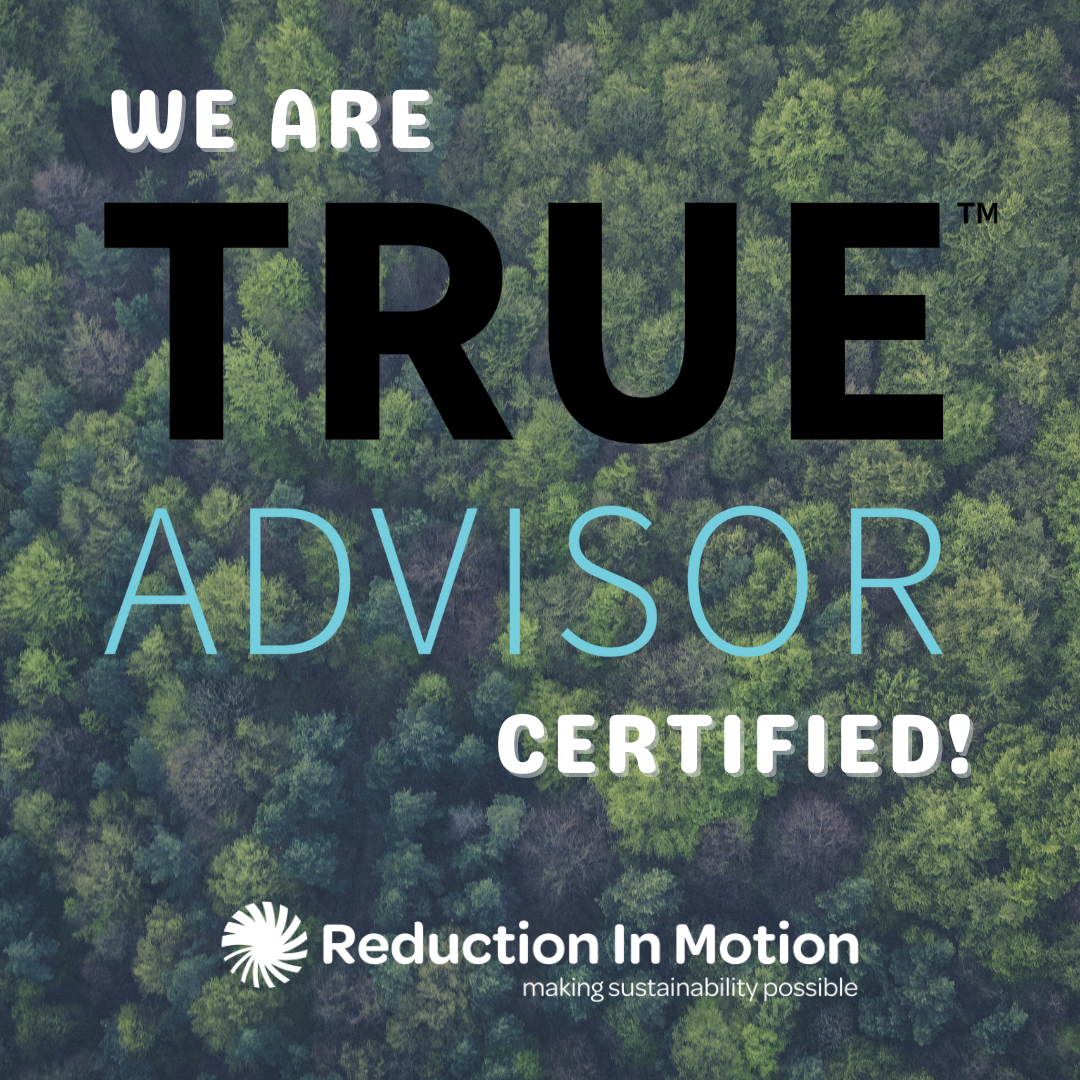LEED Waste Audit Process and Examples
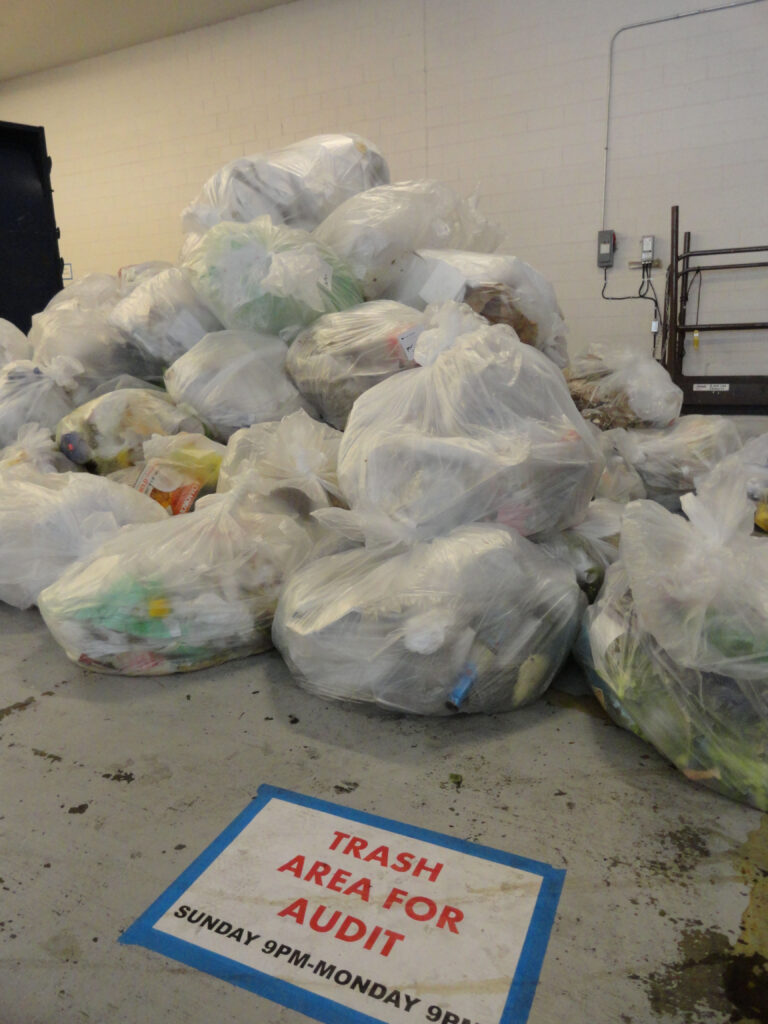
A waste audit is an examination of how waste is currently disposed to determine opportunities for improving waste reduction and diversion efforts such as recycling, composting, donation, reuse, and environmentally preferred purchasing. There are different ways to design a waste audit depending on your goals, operations, and resources. A LEED waste audit must follow specific guidelines to achieve credits within the USGBC LEED green building rating system.
Reduction In Motion provides a wide range of waste auditing services and other waste and sustainability consulting services. Contact us here or call 410-877-1593 to learn more and get a free consultation.
Designing a LEED waste audit for MRC6 credit
LEED and TRUE certifications have specific guidelines that must be followed for a waste audit to achieve credits. Requirements can include breaking data into unique locations within a building, separating waste into 12 market categories, and sorting at least 24 consecutive hours of waste per sample. Accessing specific guidelines requires a membership or working with a certified advisor. To get more information you can contact us or check out the certification sites here: LEED or TRUE.
Here’s a brief overview on the why, how, and outcomes of LEED Audits. As you read on, you’ll find out about some of the specific requirements stipulated for LEED certification credits and as a result, these types of audits are quite labor-intensive, and should be completed, in most cases, by professionals.
The Leadership in Energy and Environmental Design (LEED) rating system evaluates buildings for their environmental performance and encourages the use of green building. LEED certified buildings, by design, offer healthier and more efficient spaces resulting in lower operating costs and reduced carbon emissions.
Waste is one of the five categories used to formulate a facility’s LEED performance score, along with the Energy, Water, Transportation, and Human Experience classifications. With the data collected during our LEED Waste Audit, we’ll provide you a report with the necessary information to complete the LEED O+M MR Credit 6: Solid Waste Management Waste Stream Audit section. Our team has extensive experience completing LEED Waste Audits for office buildings, high rises, shopping centers, and professional sports complexes.
LEED Waste Audit Process
For those preparing for O+M LEED Certification or looking for a comprehensive audit, our team will typically sort a 24-hour period of waste ensuring an accurate representation of the typical waste generated. For ease, we’ll come onsite to weigh, and hand-sort all designated waste into a variety of streams, such as, landfill, organics, paper, glass, plastic, cardboard, and metal. We’ll document our observations and crunch the numbers.
If you’re looking to audit the waste yourself, be sure to review the appropriate guidelines. A few key recommendations:
- Always wear gloves
- Don’t tell occupants that you’re conducting an audit as it could skew results
- Work with housekeeping staff to ensure all desired waste is measured
- Get approval for a location to sort waste
- Know what you’re sorting and how before you start
- Make sure you have enough help
- Designate someone to record data and take pictures who isn’t sorting
- When in doubt, reach out to a professional for support
LEED Waste Audit Results
We’ll provide you with a LEED Waste Audit Report with information to fulfil the MRc6 certification as well as recommendations to maximize you landfill diversion efforts. Our LEED Waste Audits typically include the following:
- List of Waste Types: identified during the audit, with pictures, including any unique streams such as electronics or opportunities for reuse or donation
- Current Waste Separation Breakdown and Contamination Rates: which provides your current recycling rate, by waste type, with weight and as a percent of total waste audited by waste type and insight to potential contamination issues
- Landfill Avoidance Potential: if all waste was separated properly
- Waste Separation Recommendations: to improve landfill diversion program while addressing potential costly contamination and associated fees of existing recycling programs
- Waste Audit Methodology: that provides the necessary summary of audit procedures, findings, and justification that the audit was completed in a way that shows a representation of typical waste generation
LEED Waste Audit Examples
Office Commercial Building
- 27,000 square feet
- Sorted 640 lbs. of waste into 7 waste streams
- The building had a 53% recycling rate, but the recycling stream was contaminated
- 45% of items placed into the recycling were not recyclable
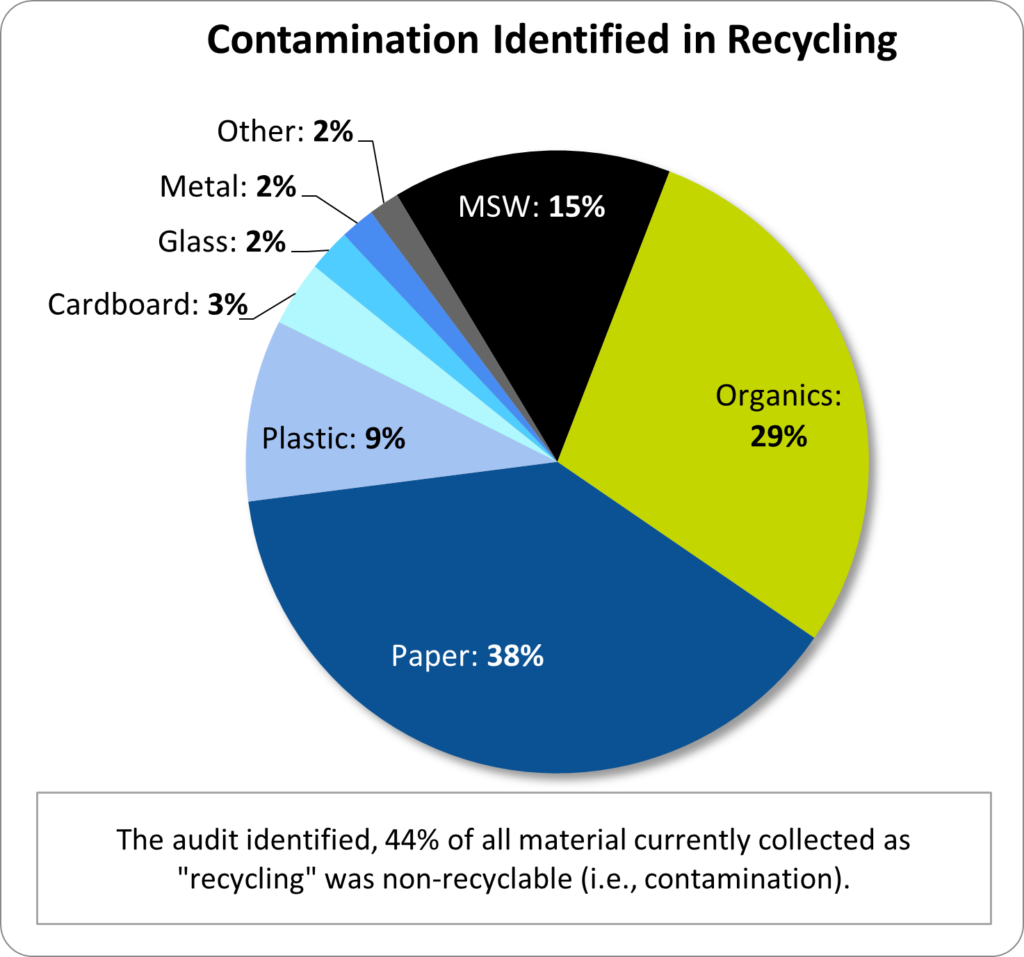
- If composting and other waste reduction and diversion programs were considered, we determined that the building could achieve 78% waste diversion
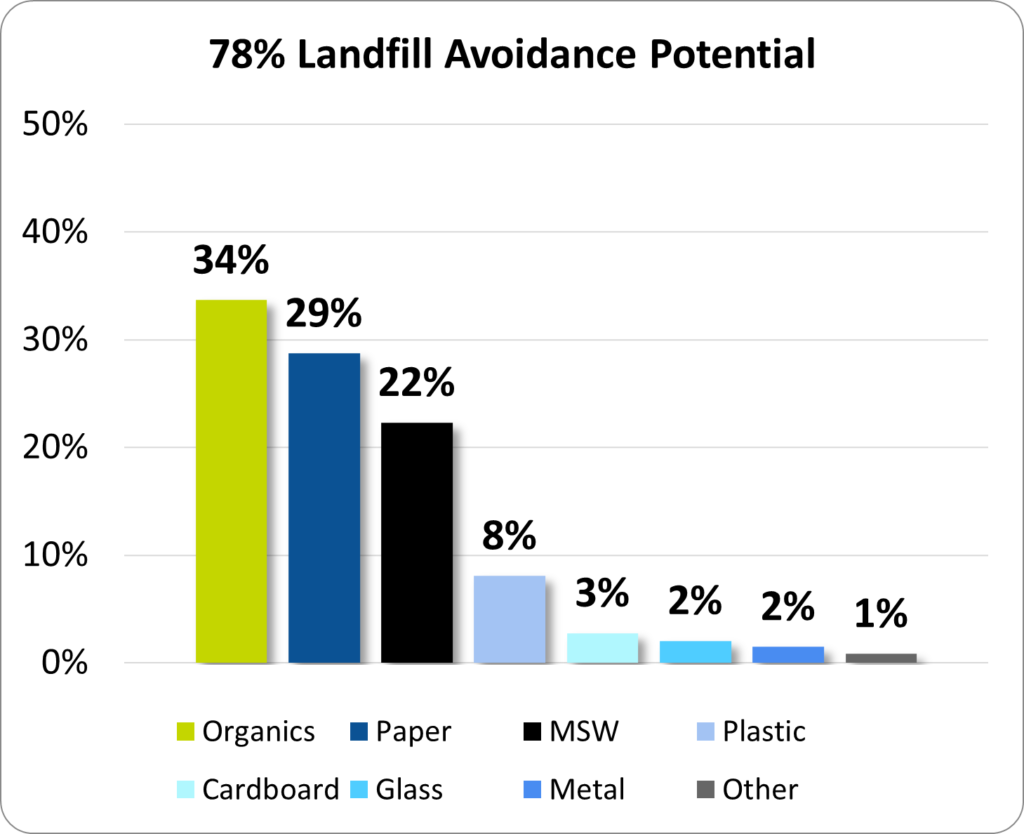
Sports Stadium
Conducting a waste audit at a sizeable venue is a great way to learn more about waste flow During a larger event (I.e., a major league sporting event). This can help identify missed opportunities and areas for improvement, such as waste container placement, contamination in the recycling, etc. Waste audits at this scale give a general idea for what can be improved and reassessed for better waste management to improve recycling and other diversion efforts. This particular client was seeking a waste audit to obtain credits for their LEED certification.
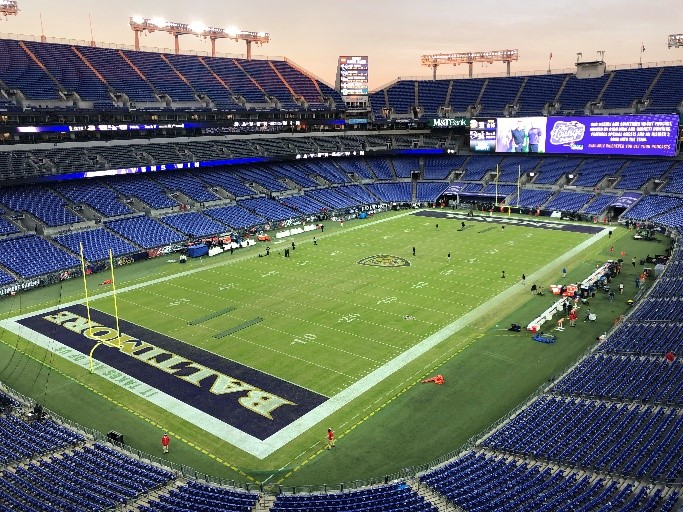
This particular waste audit was of a larger size, approx. 28,000 lbs. of waste, which required a bigger team (approx. 67 people) to sort the waste. All of the waste was collected and audited onsite. The bags of waste (recycling and trash) were brought down by venue staff and the waste audit team weighed all the bags prior to sorting. The clear bags for recycling were sorted in one section and the black bags for trash were sorted in another. Keeping these streams separate helps to understand the contamination levels in the recycling and the missed opportunities for recyclable items found in the trash. Of the bags collected, 52% were designated for recycling (clear bags and cardboard) and 48% were designated for trash (black bags).
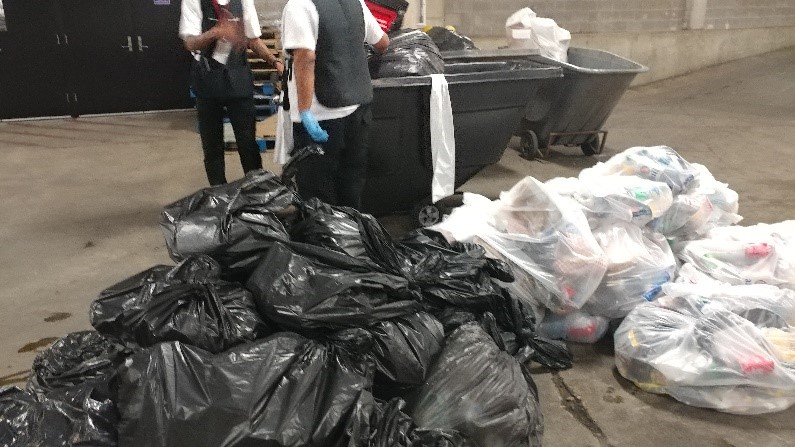
The audit team then sorted the waste into 7 categories: cardboard, mixed paper (fiber), glass, metals, plastics, wet waste (organics), and municipal solid waste (MSW). After the sorting was completed, these 7 waste streams were weighed to determine how much waste could have been diverted from landfills and the levels of contamination in the recycling.
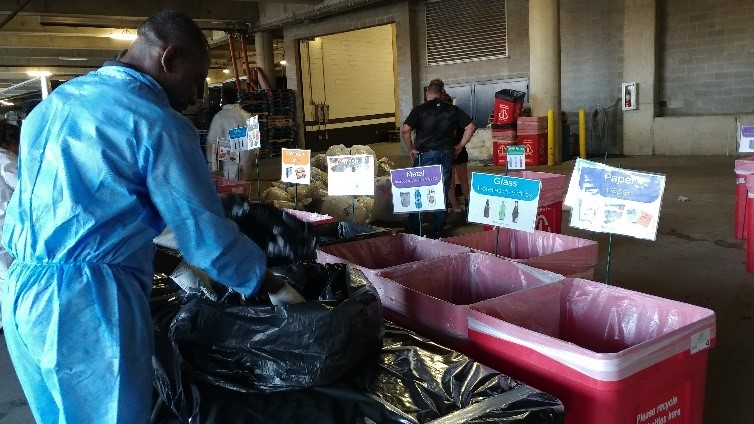
The results of this waste audit showed that of the 52% of bags designated as recycling, 42% of the material found in these recycling bags was not recyclable. Additionally, only 18% of the material found in the trash could have been recycled.
These findings show that the recycling stream has room for improvement. Recommendations such as restrictive openings in the recycling bins as well as better signage and properly lining the bins with the right color bag can help lead to less contamination in the recycling.
After the waste audit was conducted, our team provided site-specific recommendations based off of our observations for the venue’s next event to improve waste flow and waste separation. Additionally, the waste audit went towards the credits for their LEED certification.

Our team of sustainability and waste consultants work together to develop content for our site. Contact us to learn more about something we’ve written about or would like us to focus on in the future.

